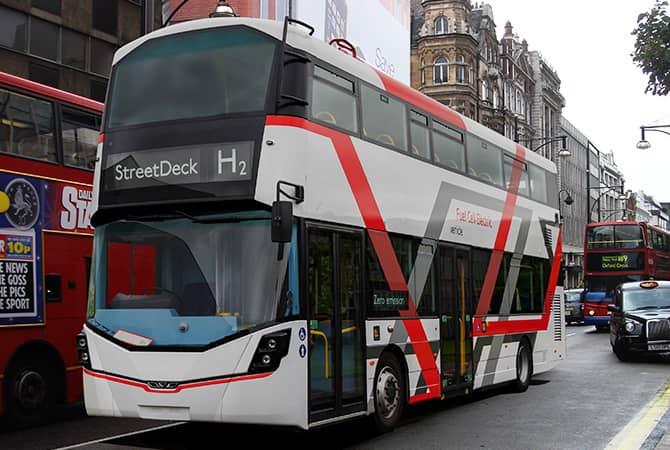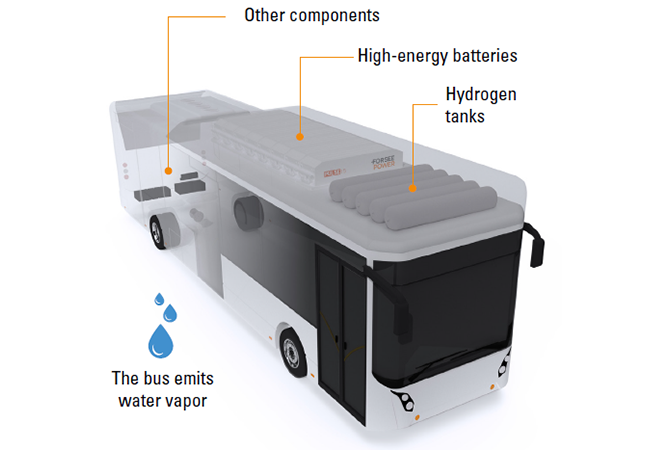Hydrogen batteries: an alternative to 100% batteries
Hydrogen batteries offer innovative zero-emission solutions for electric vehicles.
To combat global warming, hydrogen-powered vehicles, such as trains, cars, buses and lorries, are relevant options integrated into global policies. They complement renewable energies such as solar panels and wind power.
It is because we believe in the possibilities of this technology that Forsee Power is the world leader in batteries for heavy hydrogen vehicles such as buses and trucks.
Our H2 power battery solutions are therefore a recognised proposition and a high-performance alternative to 100% battery-powered vehicles.
A credible alternative for accelerating the energy transition by limiting costs and extending the service life of vehicles in operation

First and foremost, a hydrogen hybrid vehicle has a battery. This works in conjunction with the hydrogen fuel cell(s). The battery is supplied by hydrogen tanks. In the case of buses, these are stored on the roof of the vehicle. The fuel cell produces energy, which is then used to power the electric motor. For this reason, in this type of hybrid vehicle, hydrogen is the main source of energy.
The batteries are charged by the electricity from the fuel cell. They are used to produce additional energy. This is used when the bus encounters sudden variations in load when accelerating or climbing steep gradients.
So, depending on the situation, the hydrogen bus is driven by the battery, by the fuel cell or by both if extra power is needed.
The advantages of the hydrogen battery
Hydrogen-powered mobility solutions offer a number of advantages. Firstly, charging is very fast. For example, LTO cells can be recharged in three to five minutes for vehicles with hybrid diesel or hybrid hydrogen engines. What’s more, their long service life means they can operate for up to 15 years. This makes them a highly attractive investment for companies or local authorities looking to reduce their operating and transport costs.
What’s more, hydrogen has a high storage capacity. Compared with the storage capacity of lithium ion batteries, the energy density of hydrogen storage is high, at approximately 120 megajoules per kilogram. For this reason, hybrid powertrains are an excellent way of combining the electrical and hydrogen storage systems to guarantee excellent performance.
Finally, the electricity produced by the combination of the fuel cell and the lithium-ion battery means that the vehicle can travel several hundred kilometres without needing to recharge. So the range is just what you’d expect from a public transport system.
Hydrogen or H2 is the most abundant molecule in the Universe. There is little or no pure hydrogen, so it has to be produced on an industrial scale. Highly concentrated, it can be transported, stored and supplied with energy without emitting greenhouse gases. It has three times more energy per kilogram than petrol. The United States and China are the world’s main suppliers, with annual production of around 10 million tonnes each.
Over 95% of the hydrogen consumed worldwide has a significant carbon footprint, as it is produced from fossil fuels (gas, oil, coal). For example, 1 tonne of grey hydrogen is equivalent to 10 tonnes of CO2 emitted into the atmosphere.
But hydrogen can also be produced in a carbon-free way using electrolysis technology, provided that the electricity used to produce it is itself carbon-free (water + renewable energies). This ‘green’ production accounts for 5% of global production, and is 4 times more expensive than grey hydrogen.
The challenge for green hydrogen is to reverse this trend!
How a hydrogen battery works
First and foremost, a hydrogen hybrid vehicle has a battery. This works in conjunction with the hydrogen fuel cell(s). The battery is supplied by hydrogen tanks. In the case of buses, these are stored on the roof of the vehicle. The fuel cell produces energy, which is then used to power the electric motor. For this reason, in this type of hybrid vehicle, hydrogen is the main source of energy.
The batteries are charged by the electricity from the fuel cell. They are used to produce additional energy. This is used when the bus encounters sudden variations in load when accelerating or climbing steep gradients.
So, depending on the situation, the hydrogen hybrid bus is driven by the battery, by the fuel cell or by both if extra power is needed.

The H2. City Gold buses from CaetanoBus
CaetanoBus has chosen Forsee Power to equip its H2. City Gold hybrid hydrogen buses. High-power PULSE 15 batteries have been installed on the roof. Combined with five hydrogen tanks, they enable the H2. City Gold to travel up to 400 km without emitting any CO2.
Hyliko’s hydrogen-powered trucks
Hyliko has selected Forsee Power as its partner to equip its first hydrogen trucks with PULSE 2.5 battery solutions. From 2023, we will be equipping a 44t tractor and a 26t rigid vehicle from the French manufacturer.
Forsee Power’s PULSE 2.5 modules offer a high level of high-power performance in a compact package, making it possible to optimise the architecture of hydrogen-powered HGVs for enhanced performance in use.
StreetDeck hydrogen buses
Forsee Power and Wrightbus have extended their cooperation in the field of hydrogen buses. Thanks to this initiative, Wrightbus won the JIVE (Joint Initiative for Hydrogen Vehicles Across Europe) tender. As a result, the company has taken almost a hundred orders for hydrogen buses in major cities such as London, Liverpool and Aberdeen.
These multi-storey buses were fitted with extra-flat PULSE 2.5 modules, as it was impossible to install them on the roof. Equipped in this way, the StreetDeck H2 buses have a range of 320 km.
Contact us
For more personalised assistance with your project, contact us directly.
